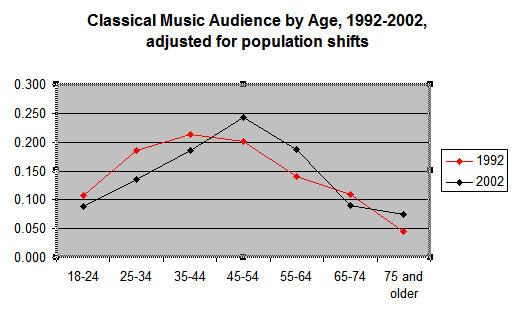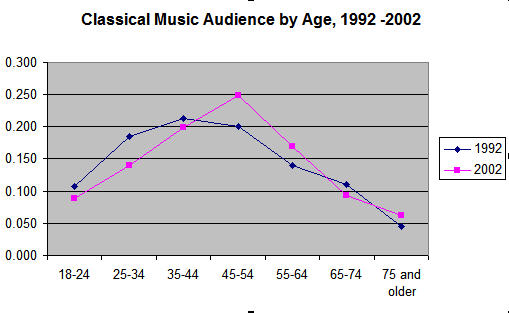Because this history isn’t well known, I thought I’d summarize some of the data I’ve uncovered about American orchestras in the past, and their audience. (Even at the risk of repeating myself.) This first post shows the data on the audience’s age. This data teaches two lessons:
We can no longer say the orchestra audience has always been the age it is now. That’s just not true.
We can’t assume that younger people will start going to classical concerts when they grow older, as past generations did.
Here’s the data. In 1937, the average age of the orchestra audience apparently was — believe it or not! — about 30. [Source: America’s Symphony Orchestras and How They Are Supported, a 1940 book by Margaret Grant and Herman S. Hettinger, which records the results of a study of American orchestras conducted in 1937.] The study only looked at the audience of two orchestras, the Grand Rapids (MI) Symphony, and the Los Angeles Philharmonic. But Grant and Hettinger report the results with no apparent surprise, which makes me think the data reflects what anybody at the time would have noticed at more or less any orchestra event. Besides, this finding is consistent with the next entry on this list, as you’ll see.
In the early 1960s, the average age of the orchestra audience apparently was 38. [Source: a study conducted by the Twentieth Century Fund, and reported in The Performing Arts: The Economic Dilemma, by William J. Baumol and William G. Bowen, who were in charge of the study.] The age statistic is actually for all the performing arts, taken together. But Baumol and Bowen explicitly say that the data for all the performing arts was remarkably similar, and they also make a point of stating, with much emphasis, that one of the most notable characteristics of the performing arts audience is that it’s young. At one point they even speculate that people simply stop going to performing arts events as they grow older. This makes amazing reading nowadays; we make the opposite assumption.
From 1982 to 2002, the age of the classical music audience kept increasing. The source for this is various studies, partly based on census data, conducted by the National Endowment for the Arts. In 1982 the average age of this audience was 40, in 1992 it was 45, in 2002 it was 49. Of course, this is the entire classical music audience, not just the people who go to orchestra concerts. But the orchestra audience would surely be about the same age (if not older, though I think the chamber music audience — at least now — might be older still). And it would surely be aging at about the same rate.
Some of this age increase is due to the aging of the population as a whole, but not all of it. And note this very telling finding, quoted from the Executive Summary of a 1997 NEA report:
The classical music audience is aging faster than the population as a whole. In 1982 those under thirty years of age comprised 26.9 percent of the audience and by 1997 comprised just 13.2 percent of the audience. [By 2002, they’d fallen to 8.8 percent.] Over this same span of years, those over sixty years of age rose from 15.6 percent to 30.3 percent of the classical music audience.
Here’s a graph I made, showing how the audience aged between 1992 and 2002. (I adjusted the data to reflect changes in the age distribution of the population at large. See the end of this post for more about that.) The trend couldn’t be clearer:

All this later data of course tends to confirm the admittedly fragmentary 1937 data. If the audience has been aging so strongly since the early ‘60s, it could plausibly (though, I admit, not inevitably) have been aging since the 1930s.
Some lessons from this: We have to stop saying that the orchestra audience has always been the age it is now. Clearly that isn’t true. And we don’t even have to go back to 1937 to make this point. The orchestra audience has aged during the past 30 years.
We have to stop thinking of age groups, and think instead about what demographers call “cohorts.” A cohort is a group of people born around the same time. The cohort that was under 30 in 1982 made up 26.9 percent of the classical music audience. (I’m speaking very roughly here; demographers define cohorts more precisely than I’m doing.) The cohort of people under 30 in 1997 was only 13.2 of the audience. So the two cohorts differ greatly in their interest in classical music (or at least in their interest in going to classical concerts). The 1997 cohort was much less interested. And look again at my graph of the aging audience. Doesn’t this suggest that (very roughly speaking) one cohort somewhat dominates the classical music audience, forming a bigger part of it than any other cohort? These are the people born between 1948 and 1957. In 1992, they were 35 to 44 years old, and formed the largest part of the classical music audience, as the graph shows. And in 2002, they still formed the largest part of 1992the audience, but now of course were 10
years older.
Note, by the way, that their dominance is even greater in 2002 than it was in 1992. And the chart shows why. It’s because younger cohorts weren’t coming into the audience as much as they once did. The younger age groups sag in the 2002 graph, which then makes the 45 to 54 group and the 55 to 64 group a bigger proportion of the audience than they used to be.
All this has consequences. One of them, I’d think, is that we have to stop assuming that people now in their younger years will start coming to orchestra concerts as they grow older. Or at least we’ll have to stop assuming that they’ll do it at the rate that earlier generations did. Just go back to my summary of the NEA data, and think about the under-30 cohorts in 1982 and 1997.
Can we really expect both to show an equal interest in classical music as they age? I don’t think so. The 1997 under-30 cohort didn’t have as much interest as the 1982 under-30 cohort did. So isn’t it likely — or at least very possible — that as they grow older they’ll continue to show less interest? Now, in 2006, they’re nearing 40. Conventional wisdom says they’ll start buying tickets in another 10 years, when they’re nearing 50. But why should we expect them to, given their striking lack of interest — compared to past generations — when they were young?
***
Footnote on the adjusted data in my graph: The age distribution of the population as a whole changes over time. Generally we’ve been getting older. (I’m speaking as an American, about the population of the United States.) And this means that changes in the age distribution of the classical music audience have to be looked at more carefully.
For instance, in 1992, people 18 to 24 years old made up 13 percent of the population. In 2002, that percentage hadn’t changed. So when we see that this age group declined during that period from 10.7 percent of the classical music audience to 8.8 percent, this decline means something. It reflects a real change in the classical music audience. But now suppose the percentage of these people in the general population hadn’t stayed steady. Instead, suppose it had declined in the general population by the same percentage that it declined in the classical music audience. Then the lower percentage of people 18 to 24 in the classical music audience wouldn’t mean anything. Or, more precisely, it wouldn’t tell us anything about anybody’s interest in classical music. We’d be seeing fewer people of this age at classical concerts only because there are fewer of them everywhere.
Making these adjustments doesn’t lead to giant changes. The data stays pretty much the same. But it’s good practice to make these adjustments, I think, and I find it makes the trends a little clearer. Here, for anybody curious, is my earlier graph, but now with the data not adjusted for population shifts:

And by the way: some of you might have noticed that the percentage of 18 to 24 year-olds in the classical music audience actually rose between 1992 and 1997, from 10.7 percent to 12.8 percent. And then it fell again in 2002. What’s that about? Does it reflect an oddball, temporary jump in interest, or instead does it reflect some change in the NEA’s methodology? I haven’t studied this nearly enough, but my instinct is to trust the 1997 data less than the 1982, 1992, and 2002. Those last figures come from the U.S. census, so I believe they ought to be generally comparable. Note, though, that the 1997 data doesn’t make any change in the overall trends.

Interesting stuff! The datum that the audience tends strongly toward those born between 1948-1957 (typo alert — the post currently says “1857”) correlates well with my utterly unscientific view of the folks shopping for classical CDs at my store. The other two larger groups among the shoppers are the very old (I’m guessing 70+) and about 14-25 — though these almost all turn out to be conservatory students themselves. Oh, and there’s also what seems to be an anomalous group outside of these ages — but they’re almost always shopping (often blindly and frantically) for presents for people in peak groups.
To what extent do you take into account the music student population. Anecdotally speaking, this seems to have grown tremendously in the last 20 years. Youth symphony populations have mushroomed across the nation in the last 20 years. At Harvard University (which cannot be seen as a bellwether but may provide some interesting info nonetheless), where 50 years ago there only existed one 50-70-piece orchestra — now there exist 5 student-run orchestras, all of which are, particularly among strings, competitive to get into, and three opera companies that put on a show every year. The vast majority of the people involved in these groups do NOT go into music, yet are clearly avidly interested in it. Is it possible that even as general interest in listening to classical music has declined, that interest in playing it has gone up? And if this is true, what does it mean?
The key is getting good looking women in the stands, preferable in the most visible seats. Then, put them on the jumbotron . . .